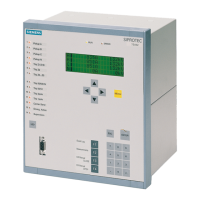The monitoring time Max. DEAD EXT. is started after the configured dead time has elapsed.
This time must not be shorter than CB TIME OUT. When using the monitoring time CB TIME OUT, the time
Max. DEAD EXT. should be set to a value ≥ CB TIME OUT.
Since the synchronization is used as synchrocheck, the monitoring time can be set quite short, for example to
a few seconds. The synchronization function merely "checks" the synchronism of the power systems. If
synchronism is detected, it will be connected instantaneously, otherwise it will not.
Generally, the monitoring time should be longer than the maximum duration of the synchronization process
(parameter 6112).
The breaker failure monitoring time 7114 T-Start MONITOR determines the time between tripping (closing
the trip contact) and opening the circuit breaker (checkback of the CB auxiliary contacts or disappearing device
pickup if no auxiliary contacts are allocated). This time is started each time a tripping operation takes place.
When time has elapsed, the device assumes breaker failure and blocks the automatic reclosure function
dynamically.
Action Time
The action time monitors the time between pickup of the device and trip command of a protective function
configured as starter while the automatic reclosure function is ready but not yet running. A trip command
issued by a protective function configured as starter occurring within the action time will start the automatic
reclosing function. If this time differs from the setting value of T-ACTION (address 7117), the automatic
reclosure function will be blocked dynamically. The trip time of inverse tripping characteristics is considerably
determined by the fault location or fault resistance. The action time prevents reclosing in case of far remote or
high-resistance faults with long tripping time. Trip commands of protective functions which are not config-
ured as starter do not affect the action time.
Delay of Dead Time Start
The dead time start can be delayed by pickup of the binary input message 2754
>79 DT St.Delay
. The
maximum time for this can be parameterized under 7118 T DEAD DELAY. The binary input message must be
deactivated again within this time in order to start the dead time. The exact sequence is described in the func-
tional description at margin heading "Delay of Dead Time Start".
Number of Reclosing Attempts
The number of reclosing attempts can be set separately for the "phase program" (address7136, # OF RECL.
PH) and "ground program" (address 7135 # OF RECL. GND). The exact definition of the programs is
described in the functional description at margin heading "Reclosing Programs".
Close Command: Direct or via Control
Address 7137 Cmd.via control can be set to either generate directly the close command via the automatic
reclosing function (setting Cmd.via control = none) or have the closing initiated by the control function.
If the automatic reclosure function is to be closed via the control function, the manual closing command has
to be suppressed during an automatic reclose command. The example in the Section 2.2.11 Setting Notes of a
MANUAL CLOSE for commands via the integrated control function has to be extended in this case (see
Figure 2-94). The messages 2878
79 L-N Sequence
and 2879
79 L-L Sequence
indicate that the AR has
been started and wants to carry out a reclosure after the dead time. The annunciations set the flipflop and
suspend the manual signal until the AR has finished the reclosure attempts. The flipflop is reset via the OR-
combination of the annunciations 2784
79 is NOT ready
, 2785
79 DynBlock
and 2862
79
Successful
. Manual closing is initiated if a CLOSE command comes from the control function.
Functions
2.15 Automatic Reclosing System 79
220 SIPROTEC 4, 7SJ80, Manual
E50417-G1140-C343-A8, Edition 12.2017

